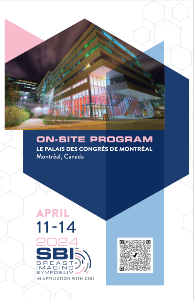Back
BI
BMRI
DBT
DMO
NM
US
Evaluating the Association between Allostatic Load and Malignant Pathology Result on Image-guided Core Needle Breast Biopsy
Saturday, April 13, 2024
11:15 AM – 11:20 AM
Location: 517

Lily Kwak, BA
Medical Student
Johns Hopkins University School of Medicine
Johns Hopkins University School of Medicine
Abstract Podium Presenter(s)
Purpose: Allostatic load (AL) is a composite measure of physiologic dysregulation representing cumulative effect of repeated activation of the stress response system, such as that resulting from chronic exposure to adverse social conditions. It is believed that this could result in biological changes in the breast tissue that could predispose to malignancy. We aimed to evaluate the association between AL and malignant pathology result among women undergoing image-guided breast biopsy.
Materials and Methods: We retrospectively reviewed our electronical medical record to identify women aged 18 and older who underwent stereotactic-guided and ultrasound-guided breast biopsies at our institution from April 1st, 2017 to March 31st, 2022. AL was calculated using clinical lab metrics associated with four major physiological systems – cardiovascular (heart rate, systolic/diastolic blood pressure, total cholesterol, high-density lipoprotein, low-density lipoprotein), immune (white blood cell count), metabolic (BMI, albumin, hemoglobin A1C), and renal (creatinine, estimated glomerular filtration rate). We evaluated the association between AL and pathology result using multivariable logistic regression, after controlling for age, race, ethnicity, and breast cancer risk using Gail Lifetime risk score, and area deprivation index (ADI).
Results: 254 patients were included, 55.9% (n=142) had benign pathology, 16.1% (n=41) had high-risk pathology, and 28% (n = 71) had malignant pathology. Participants’ mean age was 61 +/- 12. A total of 31.1% (n=79) were White, 3.5% (n=9) Asian, and 59.8% (n = 152) were Black. 4.3% (n= 11) identified as Hispanic. Median AL was 4 (IQR 2-5). Median ADI score for the group was 52 (IQR 29-78). After adjustment for age, Gail Lifetime risk score and ADI, higher AL was associated with 27% increase in odds of malignant pathology (adjusted Odds Ratio, aOR: 1.27, 95%CI: 1.01 to 1.58, p = 0.037). Neither Gail Lifetime risk score nor ADI were associated with malignant pathology in these patients, after controlling for age and AL. There were no associations between race or ethnicity and pathology result (p = 0.61, 0.30).
Conclusion: Our study results suggest that increased AL is associated with malignant pathology result in women undergoing image-guided core needle breast biopsy.
Clinical Relevance Statement: Increased AL is a biologic measure of chronic stress and is associated with increased risk of malignant pathology on breast biopsy, which could improve understanding of underlying determinants of socioeconomic breast cancer disparities and could be factored into efforts to construct personalized supplemental screening guidelines for at-risk populations.
Materials and Methods: We retrospectively reviewed our electronical medical record to identify women aged 18 and older who underwent stereotactic-guided and ultrasound-guided breast biopsies at our institution from April 1st, 2017 to March 31st, 2022. AL was calculated using clinical lab metrics associated with four major physiological systems – cardiovascular (heart rate, systolic/diastolic blood pressure, total cholesterol, high-density lipoprotein, low-density lipoprotein), immune (white blood cell count), metabolic (BMI, albumin, hemoglobin A1C), and renal (creatinine, estimated glomerular filtration rate). We evaluated the association between AL and pathology result using multivariable logistic regression, after controlling for age, race, ethnicity, and breast cancer risk using Gail Lifetime risk score, and area deprivation index (ADI).
Results: 254 patients were included, 55.9% (n=142) had benign pathology, 16.1% (n=41) had high-risk pathology, and 28% (n = 71) had malignant pathology. Participants’ mean age was 61 +/- 12. A total of 31.1% (n=79) were White, 3.5% (n=9) Asian, and 59.8% (n = 152) were Black. 4.3% (n= 11) identified as Hispanic. Median AL was 4 (IQR 2-5). Median ADI score for the group was 52 (IQR 29-78). After adjustment for age, Gail Lifetime risk score and ADI, higher AL was associated with 27% increase in odds of malignant pathology (adjusted Odds Ratio, aOR: 1.27, 95%CI: 1.01 to 1.58, p = 0.037). Neither Gail Lifetime risk score nor ADI were associated with malignant pathology in these patients, after controlling for age and AL. There were no associations between race or ethnicity and pathology result (p = 0.61, 0.30).
Conclusion: Our study results suggest that increased AL is associated with malignant pathology result in women undergoing image-guided core needle breast biopsy.
Clinical Relevance Statement: Increased AL is a biologic measure of chronic stress and is associated with increased risk of malignant pathology on breast biopsy, which could improve understanding of underlying determinants of socioeconomic breast cancer disparities and could be factored into efforts to construct personalized supplemental screening guidelines for at-risk populations.

